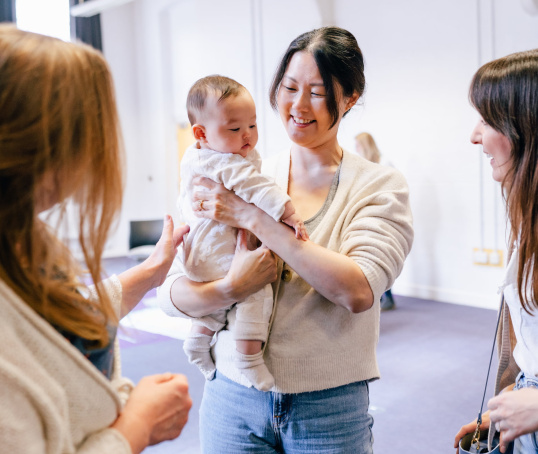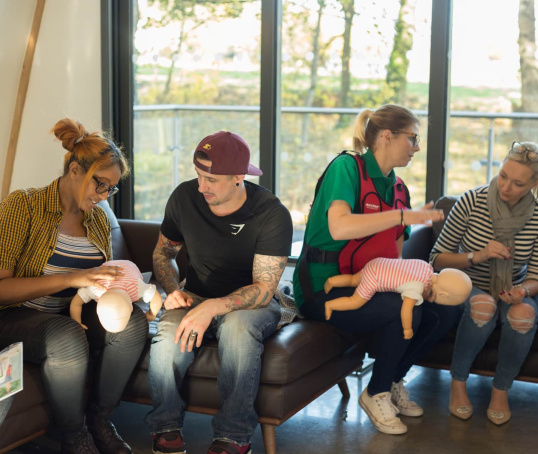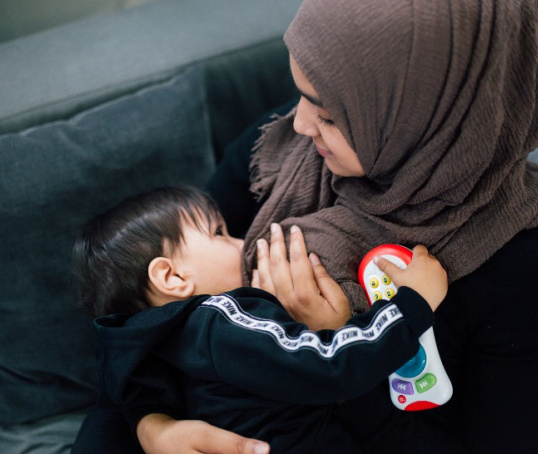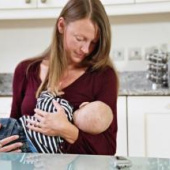If you’ve been breastfeeding your baby and want to introduce a bottle, here are some tips on how to do this.
If you want to introduce a bottle but also continue to breastfeed, it’s a good idea to make sure breastfeeding is well established before you try giving a bottle (University Hospital Southampton NHS Trust, 2014). That is unless you need to give your baby a bottle sooner for medical or other reasons (NHS, 2017).
Watch our video for tips on expressing breastmilk.
Breastfeeding should be well established beforehand because some babies find learning to breastfeed difficult if bottles are introduced. Although there are other babies who are happy to take a bottle from early on without it seeming to affect how they breastfeed (Batista et al, 2019).
If you’re planning to stop breastfeeding, take a look at this article for tips and information.
If you’re unsure about anything, have a chat with your midwife or health visitor. You can also call our NCT infant feeding support line on 0300 330 0700 and talk to one of our breastfeeding counsellors.
10 Tips for bottle-feeding a breastfed baby
For babies who are used to being breastfed, and/or if you want to continue breastfeeding alongside bottle-feeding, these tips might be useful:
- Round teats with a wide base are believed to encourage tongue and jaw movements similar to that of sucking at the breast (Smith et al, 1988).
- Some babies may gag on a teat that is too long (Mohrbacher, 2010) so a short teat might be preferable. When a baby breastfeeds, they don’t stretch their mum’s nipple. Instead, they open their mouth wide so that the nipple reaches far back in their mouth (Mohrbacher, 2010).
- Gently brush the teat of the bottle against their lips. This should encourage their rooting reflex (Unicef, 2019).
- Hold your baby upright and maintain eye contact with them so they feel loved and safe (Unicef, 2019).
- Some babies will guzzle milk quickly from a bottle and this might then lead to them developing a preference for the flow of the bottle compared to breastfeeding (Unicef, 2015). Choose a bottle with a slow flow teat. These are often labelled as slow flow or newborn (NHS, 2018).
- Keep putting them on your breasts and give them a lot of skin-to-skin contact (UNICEF, 2018).
- Warm and soften the teat with warm, boiled water that has been left to cool down (American Academy of Pediatrics, 2011; NHS Choices, 2017).
- Offer the bottle when your baby isn’t hungry but is awake, calm and relaxed (American Academy of Pediatrics, 2011; NHS Choices, 2017).
- Try a position similar to breastfeeding, like the cradle hold (American Academy of Pediatrics, 2011; NHS Choices, 2017).
- Ask someone else to give them the bottle although it’s a good idea for only one or two adults to share the feeding. This is because everyone has a different technique and it can be confusing for a young baby to have to learn different ways (Unicef, 2014).
Cups, syringes and supplementary nursing systems: alternative feeding methods
The alternative to bottles is to use a special feeding cup, an egg cup or a plastic syringe for feeding expressed breastmilk or formula.
Why use a cup or syringe to feed your baby
These methods might be particularly useful for very new, ill or premature babies who haven’t learnt to breastfeed effectively yet (Flint et al, 2016). They’re also more practical for giving very tiny amounts of breastmilk or colostrum (the first milk you produce). It is believed that using cups or syringes minimises the risk of your baby developing a preference for the flow of the bottle (Flint et al, 2016).
How to use a cup or syringe
It can be quite messy while you and your baby are learning to use a cup or syringe, so parents often find it useful to loosely swaddle their baby. Ask your midwife to show you if you are unsure.
From around four months old, many parents have success with a soft-spouted beaker or open slanted cups. You’ll need to have your baby sitting upright, with their head free to tilt back so they can stop when they need to (Unicef, 2019).
Other options
Supplementary nursing systems are also a possibility. They allow your baby to spend time at the breast too, which will stimulate your milk supply.
Some babies never take a bottle, and they aren’t happy with a cup either until they’re older. They sometimes prefer to hang on until you come home and then help themselves to a super-long feed. This is often called reverse cycling (Kellymom, 2018).
This page was last reviewed in January 2019.
Further information
NCT supports all parents, however they feed their baby. If you have questions, concerns or need support, you can speak to a breastfeeding counsellor by calling our helpline on 0300 330 0700, whether you are exclusively breastfeeding or using formula milk. Breastfeeding counsellors have had extensive training, will listen without judging or criticising and will offer relevant information and suggestions. You can also find more useful articles here.
You might find attending one of our NCT New Baby groups helpful as they give you the opportunity to explore different approaches to important parenting issues with a qualified group leader and other new parents in your area.
Make friends with other parents-to-be and new parents in your local area for support and friendship by seeing what NCT activities are happening nearby.
National Breastfeeding Line (government funded): 0300 100 021.
NHS Choices has information on bottle feeding and breastfeeding in public.
Best Beginnings has video clips from the 'Bump to Breastfeeding' DVD.
American Academy of Pediatrics. (2011) Practical bottle feeding tips. Available from: https://www.healthychildren.org/English/ages-stages/baby/feeding-nutrition/Pages/Practical-Bottle-Feeding-Tips.aspx [Accessed 4th July 2019].
Batista C, Rodrigues V, Ribeiro V, Nascimento M. (2019) Nutritive and non-nutritive sucking patterns associated with pacifier use and bottle-feeding in full-term, infants. Available from: https://doi.org/10.1016/j.earlhumdev.2019.03.007 [Accessed 4th July 2019]
Flint A, New K, Davies MW. (2016) Cup feeding versus other forms of supplemental enteral feeding for newborn infants unable to fully breastfeed. Cochrane Database Syst Rev. (8):CD005092. Available from: https://www.cochranelibrary.com/cdsr/doi/10.1002/14651858.CD005092.pub3… [Accessed 4th July 2019]
Kellymom. (2018). Reverse cycling. Available from: https://kellymom.com/bf/normal/reverse-cycling/. [Accessed 4th July 2019]
NHS. (2016) Sterilising bottles. Available from: https://www.nhs.uk/conditions/pregnancy-and-baby/sterilising-bottles/ [Accessed 4th July 2019].
NHS. (2017) How to combine breast and bottle feeding. Available from https://www.nhs.uk/conditions/pregnancy-and-baby/combining-breast-and-bottle/ [Accessed 4th July 2019]
NHS. (2018) Bottle feeding advice. Available at: https://www.nhs.uk/conditions/pregnancy-and-baby/bottle-feeding-advice/ [Accessed 1st May 2019]
NICE. (2014) Breastfeeding recommendations. Available from: https://www.nice.org.uk/guidance/PH11/chapter/4-Recommendations#breastfeeding-3 [Accessed 4th July 2019].
UNICEF. (2014) A guide to infant formula for parents who are bottle feeding: health professionals’ guide. Available from: https://www.unicef.org.uk/babyfriendly/wp-content/uploads/sites/2/2016/12/Health-professionals-guide-to-infant-formula.pdf [Accessed 4th July 2019]
UNICEF. (2018) Skin to skin contact. Available from: https://www.unicef.org.uk/babyfriendly/baby-friendly-resources/guidance-for-health-professionals/implementing-the-baby-friendly-standards/further-guidance-on-implementing-the-standards/skin-to-skin-contact/ [Accessed 4th July 2019]
UNICEF. (2019) Responsive bottle feeding. Available from: https://www.unicef.org.uk/babyfriendly/wp-content/uploads/sites/2/2019/04/Infant-formula-and-responsive-bottle-feeding.pdf [Accessed 4th July 2019]
Further reading
Becker GE, Smith HA, Cooney F. (2016) Methods of milk expression for lactating women. Cochrane Database Syst Rev 29:9. Available from: https://www.ncbi.nlm.nih.gov/pubmed/27684560 [Accessed 4th July 2019].
NHS. (2009) Breast milk ingredients and sleep. Available from: http://www.nhs.uk/news/2009/10October/Pages/Breast-milk-ingredients-and… [Accessed 4th July 2019].
Science News. (2015) Backwash from nursing babies may trigger infection fighters. Available from: https://www.sciencenews.org/blog/growth-curve/backwash-nursing-babies-may-trigger-infection-fighters [Accessed 4th July 2019].







